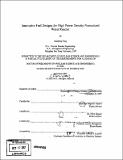| dc.contributor.advisor | Mujid S. Kazimi. | en_US |
| dc.contributor.author | Feng, Dandong, Ph. D. Massachusetts Institute of Technology | en_US |
| dc.contributor.other | Massachusetts Institute of Technology. Dept. of Nuclear Science and Engineering. | en_US |
| dc.date.accessioned | 2008-04-23T14:40:36Z | |
| dc.date.available | 2008-04-23T14:40:36Z | |
| dc.date.copyright | 2005 | en_US |
| dc.date.issued | 2006 | en_US |
| dc.identifier.uri | http://hdl.handle.net/1721.1/41283 | |
| dc.description | Thesis (Ph. D.)--Massachusetts Institute of Technology, Dept. of Nuclear Science and Engineering, February 2006. | en_US |
| dc.description | Includes bibliographical references (p. 229-232). | en_US |
| dc.description.abstract | One of the ways to lower the cost of nuclear energy is to increase the power density of the reactor core. Features of fuel design that enhance the potential for high power density are derived based on characteristics of the pressurized water reactor (PWR) and its related design limits. Those features include: large fuel surface to volume ratio, small fuel thickness, large fuel rod stiffness, low core pressure drop and an open fuel lattice design. Three types of fuel designs are evaluated from the thermal-hydraulic point of view: conventional solid cylindrical fuel rods, internally and externally cooled annular fuel rods, and spiral cross-geometry fuel rods, with the major effort allocated to analyzing the annular fuel. Limits of acceptable power density in solid cylindrical fuel rods are obtained by examining the effects of changing the core operation parameters, fuel rod diameter and rod array size. It is shown that the solid cylindrical geometry does not meet all the desired features for high power density well, and its potential for achieving high power density is limited to 20% of current PWR power density, unless the vibration problems at the coolant higher velocity are overcome. The internally and externally cooled annular fuel potential for achieving high power density is explored, using a whole core model. The best size of fuel rods that fits in the reference assembly dimension is a 13x13 array, since the hot red will have a balanced MDNBR in the inner and outer channels. With proportional increase in coolant flow rate, this annular fuel can increase PWR power density by 50% with the same DNBR margin, while reducing by 1000 'C the peak fuel temperature. Five issues involving manufacturing tolerances, oxide growth on rod surfaces, inner and outer gap conductances asymmetry, MDNBR sensitivity to changes in core operation parameter and resistance to instabilities were also evaluated. | en_US |
| dc.description.abstract | (contd.) It is found that the main uncertainty for this design is associated with the heat split between the inner and outer channels due to differences in the thermal resistances in the two fuel-clad gaps. Annular fuel is found to be resistant to flow instabilities, such as Ledinegg instability and density wave oscillation due to high system pressure and one-phase flow along most of the hot channel length. Similar power density uprate is found possible for annular fuel in a hexagonal lattice. Large break loss of coolant accident (LBLOCA) for the reference Westinghouse 4-loop PWR utilizing annular fuel at 150% power is analyzed using RELAP, under conservative conditions. The blowdown peak cladding temperature (PCT) is found to be lower because of the low operating fuel temperature, but the flow rate from the safety injection system needs to be increased by 50% to remove the 50% higher decay heat. Loss of flow analysis also showed better performance of the annular fuel because of its low stored energy. The fuel design that best meets the desired thermal and mechanical features is the spiral cross-geometry rods. The dimensions of this type of fuel that can be applied in the reference core were defined. Thermal-hydraulic whole-core evaluations were conducted with cylindrical fuel rod simplification, and critical heat flux modification based on the heat flux lateral non-uniformity in the cross geometry. This geometry was found to have the potential to increase PWR power density by 50%. However, there are major uncertainties in the feasibility and costs of manufacturing this fuel. | en_US |
| dc.description.statementofresponsibility | by Dandong Feng. | en_US |
| dc.format.extent | 259 p. | en_US |
| dc.language.iso | eng | en_US |
| dc.publisher | Massachusetts Institute of Technology | en_US |
| dc.rights | M.I.T. theses are protected by
copyright. They may be viewed from this source for any purpose, but
reproduction or distribution in any format is prohibited without written
permission. See provided URL for inquiries about permission. | en_US |
| dc.rights.uri | http://dspace.mit.edu/handle/1721.1/7582 | en_US |
| dc.subject | Nuclear Science and Engineering. | en_US |
| dc.title | Innovative fuel designs for high power density pressurized water reactor | en_US |
| dc.type | Thesis | en_US |
| dc.description.degree | Ph.D. | en_US |
| dc.contributor.department | Massachusetts Institute of Technology. Department of Nuclear Science and Engineering | |
| dc.identifier.oclc | 213481201 | en_US |
